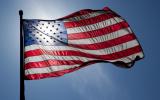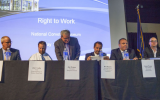Columbia Lions Fall Prey to Union Hyenas

By Olivia Grady
Columbia University in New York City is now the first Ivy League school with unionized graduate students. This comes after a long public argument between university administrators and union leaders over whether graduate students should be considered employees.
On August 23, 2016, the National Labor Relations Board (NLRB) ruled that graduate students who are teaching and research assistants are school employees at private universities. This ruling allowed these students to join or form a union.
The case started when teaching and research assistants at Columbia and the New School in New York filed petitions with the NLRB in 2014 to join the United Auto Workers (UAW). The full NLRB Board decided to hear the case after a regional board director rejected it.
Stanford University, the Massachusetts Institute of Technology and all 8 Ivy League schools submitted a brief opposing collective bargaining for the students. The universities argued that because teaching is required to graduate from a doctoral program, these graduate students are primarily students, not employees. The schools further argued that the bargaining process would disrupt university operations and add expense and red tape. This would hurt the students.
The pro-union graduate students responded that they are employees, but without the same rights as other employees. They say that the scholarships, stipends and health insurance they have previously had access to aren’t enough to support themselves or their families.
Laura Jung, an anthropology doctoral candidate at American University, explained why students should be able to unionize in an August 23, 2016 Washington Post article titled “Are they students? Or are they employees? NLRB rules that graduate students are employees.”:
“Being a teaching and research assistant is important; it’s given me valuable classroom experience. What we do has an educational benefit, but the fact of the matter is we’re not paid fair wages. We work well over the hours we’re supposed to and as a result wind up being paid minimum wage or less. That’s not enough to live in D.C. Trying to make ends meet every month is virtually impossible.”
The NLRB’s decision to side with pro-union students is surprising because it overturns a 2004 ruling from Brown University. The NLRB said in that case that unionizing graduate students would harm graduate education.
On December 9, 2016, Columbia University graduate students voted 1,602 to 623 to join the UAW. The UAW will now represent 3,500 research and teaching assistants.
The UAW quoted a Columbia teaching assistant in its December 9, 2016 statement about the vote to unionize Columbia graduate students:
“Today, 3,500 RAs and TAs like me have won a voice to make sure Columbia University is the best place possible to learn and work,” said Architecture teaching assistant Addison Godel at Columbia University, in a statement. “This marks a major victory for the entire Columbia community.”
UAW Region 9A (New York City) Director Julie Kushner was also pleased with the vote:
“This is just the beginning of great things to come for the Columbia community and we’re proud to stand with graduate workers to bargain collectively for important improvements to pay and benefits that strengthen academic quality and student success. By standing together, Columbia graduate workers have paved the way for thousands of other research assistants and teaching assistants to have a recognized voice in America’s higher education and build the institutions that we need for a more fair, just and equitable country.”
The UAW has 38,500 members at 48 universities. Many of these members are graduate students at public universities who are covered by state collective bargaining laws, rather than the National Labor Relations Act. Fourteen states have given collective bargaining rights to graduate students, including California and New York. Some private universities, like New York University, have allowed graduate student unions despite previous NLRB rulings.
Of course, the United Automobile Workers, a union that represents auto workers, is clearly not able to represent graduate students; to our knowledge, these students are not in an assembly line.





